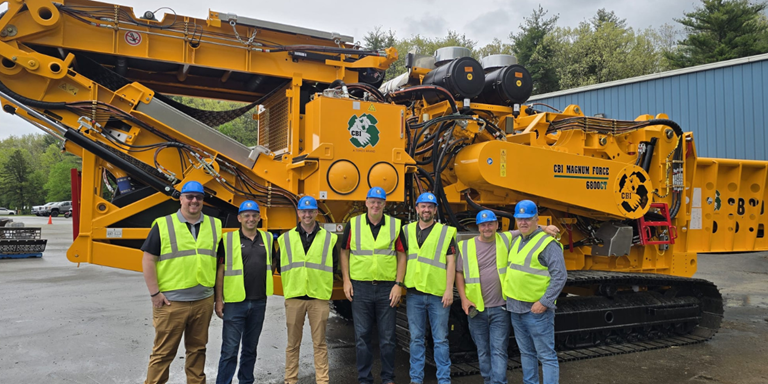How does CBI combat the inevitable? CBI starts by building their machines to handle the rigors of real world grinding applications and protects them against tramp metal with the industry leading Metal Detection System (MDS), a system precise enough to detect a bag of bolts in a plastic sandwich bag before they enter the chamber.
It’s all possible through harmonic frequency data.
MDS uses an accelerometer to detect and monitor the rotor’s vibration patterns, picking up the unique harmonic frequency of metal hitting metal and translating the change to a user dashboard mounted on the side of the machine. Milliseconds after tramp metal strikes the rotor, the MDS system automatically stops the rotor, raises the top feed roller, reverses the infeed, sets the engine to an idle, and goes into a controlled shutdown of the machine. This pre-measure prevents damage to the machine long before it becomes an issue.
An intuitive display screen lets the end user set “trip point” sensitivity on a scale of zero to five, tailoring the system to the application.
As a second line of defense against tramp metal, CBI grinders also feature shear pins to protect the grate frame, rotor and anvil.
Jim Burns of Northern Land Clearing has worked in the clearing end of the business for more than 25 years and didn’t always have a metal detection system on his grinder.
“I always left the window open on the excavator to listen for steel on the grinders because as operators we have to fix our machines ourselves,” Burns said. “We don’t have a team of mechanics that follow. We’ve always been real leery of what we put in them because we have to fix them.”
Burns admits to being skeptical of the MDS system. He thought that he could hear the steel go through long before anything else could pick it up.
After adding MDS technology to their grinder, they never looked back.
“In a month we would go through a dozen face plates depending on what we were grinding,” Burns said of his operation prior to MDS. “After we did decide to get the MDS System and put it on the machine, the first month we went through none, the second month we went through none, and then we were kind of looking at each other saying ‘Oh my God what’s happened here we almost made a mistake by not getting this.’ We saved the company money from downtime and putting the face plates on and from us having to get inside and do our normal gig of welding and turning wrenches.”
Earlier in 2017, Burns recalls one instance where the MDS system prevented significant damage to his machine.
“I was working for the town of Bedford, Massachusetts,” Burns said. “We were doing their wood waste pile and I hit a hunk of cutting edge off a bucket loader—I’d say two feet long and an inch thick—it hit the wheel and immediately MDS kicked in; wheel goes up, infeed goes back.”
Randy Wyrick of Powerscreen California and Hawaii sees the MDS system in action on a regular basis. His unit was set to 2.2 when a 14-inch metal pry bar struck the rotor during a recent demo in California.
“We were running green waste in the 6800BT and trying to keep up with the machine when the operator dropped a load into the unit that had some tramp metal hidden in there,” Wyrick said. “All the sudden the machine took a metal hit, the roll raised up and locked out, the feed chains went in reverse, and the machine shut down—notifying the operator that a piece of metal had got into the system. We inspected the rotor and couldn’t believe there was no damage. Then we fired the machine back up, reversed the feed chain dumping the pile on the ground and found the metal which was a piece of 14” long pry bar that had hit the rotor. We removed the metal from the pile, put if off to the side, reset the system and were up in running in probably five minutes.”
Protecting a capital equipment investment is critical to all businesses regardless of which brand of machine they’re running. Catching metal prior to going into the system prevents costly damage like bent hammers, broken tips, broken screens or other major catastrophes inside a machine’s grinding chamber—not to mention the cost of downtime.
“I would rather catch the metal prior to going into the system, or hitting the system and putting it through the system and causing twenty to thirty-thousand dollars’ worth of damage,” Wyrick said. “It’s well worth the five minutes it takes you to reset the system and inspect the machine to make sure you have no damage.”
Having worked in the grinding industry for more than 17 years, Wyrick has seen enough havoc caused by tramp metal to gain an appreciation for CBI’s cutting-edge MDS technology. Four years ago, he recounted working on a non-CBI machine that took a metal hit that it wasn’t prepared to handle.
“The metal was so large that it stacked the screens inside the unit,” Wyrick said. “It tore out the wear plate that holds the screens in. We had to replace the wear plate, the screens, the anvil, the upper screen and it also tweaked the anvil housing of the unit.”
“If any customer out there is being reactive to metal hits, than they’ve got a big pocket book where they can spend a lot of money on repairs,” Wyrick said. “Having an MDS system and being down five minutes to check the system is a small price to pay.”
MDS is available on all of CBI's horizontal grinders.





